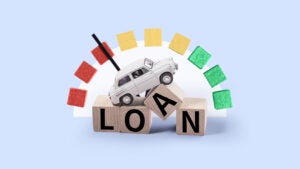How to get a car loan after bankruptcy: It’s tough but possible

Key takeaways
- Securing a competitive auto loan rate following bankruptcy is possible but will be more challenging due to the negative marks on your credit report.
- To get the best possible auto loan, it is important to keep a close eye on your credit score and work to improve it before applying for one.
- By making a down payment or adding a cosigner, you can likely receive better rates.
- It is important to shop around with a few lenders and focus on loans offered by bad credit lenders or credit unions.
Applying for a car loan after bankruptcy can feel daunting. And while it’s true that receiving a competitive post-bankruptcy car loan can take extra leg work, it is still possible. That work includes checking and improving your credit and seeking lenders with flexible eligibility requirements.
How to get a car loan after bankruptcy
Many lenders see a recent bankruptcy as a red flag. They may worry you will default on your loan if they lend to you. These extra steps can help you find a lender willing to work with you.
Step 1. Decide whether it’s smart
If you filed for bankruptcy, you’ve likely weathered some financial troubles. Think through whether seeking a car loan is the right choice for your finances.
- Affordability: Any car you purchase should be well within your budget. Ensure that it is by calculating the cost of ownership, not just the sticker price. Lenders will want to see you have a steady income source and don’t plan on spending more than you can afford.
- Current transportation: If you already have reliable transportation, it may be best to hold off on buying a car. Your interest rate will likely be less than ideal with bankruptcy still on your credit report.
- Using cash: Avoiding an auto loan before bankruptcy is off your record may be the best option. By using cash, you can skip the loan entirely.
- Potentially higher interest rates: When you have a bankruptcy on your credit report, your credit score takes a hit. And this will likely mean that the interest rates you’re offered on a car loan will be much higher than applicants who have a good to excellent credit score.
- Predatory lenders: With lending options limited because of the bankruptcy on your report, you will need to find lenders who offer more flexible eligibility requirements. But this can expose you to predatory lenders who rely upon deceptive or unethical lending terms.
Step 2. Check your credit
A bankruptcy on your credit file significantly lowers your score. Bankruptcy harms your credit for seven to 10 years, but it’s weighted less as it ages. This means your credit score will likely be higher in your ninth year of having a bankruptcy on your report compared to immediately after bankruptcy.
The better your credit is, the more favorable your borrowing terms. Check your credit score before diving into a new car loan application. This way, you can be more confident about your position as an applicant. The three main credit bureaus — Experian, TransUnion, and Equifax — can provide you with your credit score. No matter how long it’s been since your bankruptcy, it’s wise to improve your score before shopping.
Step 3. Budget for a vehicle down payment
Making a down payment often increases your odds of approval. It shows lenders you are responsible enough to save up before a big purchase. A down payment is especially important if you have a low credit score due to bankruptcy. By lowering the amount you borrow, you decrease the lender’s risk.
As a bonus for you, borrowing less money means paying less in interest over time. Experts suggest providing a down payment of at least 20 percent, but if that’s out of reach, do what you can. Use a down payment calculator to see how much money you could save with various amounts.
Step 4. Shop around
The key to finding the best car loan is comparing offers from many lenders. Each lender has its own requirements around credit score, employment history or income, so the more you check out the better chance you have of finding the right fit.
Shopping around with at least three lenders is a good rule of thumb to ensure you’re reviewing a variety of loan options and getting the best possible auto loan rate. There are various types of lenders to consider, including traditional banks, credit unions and online lenders. Dealerships also offer financing that matches you with their partner lenders.
As you browse lenders, look for ones clearly stating their credit requirements. Some will specify you need a certain credit score or cannot have recent bankruptcies. Look for lenders that allow prequalification with a soft credit check. You can check your approval odds and preview likely rates through prequalification without further hurting your credit score.
Finally, before heading into a dealership, it is a good idea to apply for loan preapproval. Preapproval requires a hard credit check, but a preapproved offer holds more weight than prequalification. It will give you negotiation power at the dealership and a firm understanding of your budget.
Consider how purchasing a new versus a used vehicle could impact your potential borrowing rates. Used cars are typically less expensive, but used car loans often come with higher interest rates.
Types of bankruptcy
The two most common types of bankruptcy are Chapter 7 and Chapter 13. When deciding whether to approve your car loan application, a lender runs a credit check. At this point, lenders will learn about your bankruptcies. Before moving forward with a new loan, it is important to understand the specifics of which you filed for.
There isn’t a fixed period of time after bankruptcy when you’re “allowed” to apply for a car loan. Lenders may require your bankruptcy to be at least 12 to 24 months in the past.
Chapter 7 bankruptcy
The court takes legal ownership of your nonexempt possessions when you file for Chapter 7 bankruptcy. Giving up these assets to be liquidated means you can walk away from most debts. This type of bankruptcy remains on your credit report for up to 10 years.
Chapter 13 bankruptcy
Filing for Chapter 13 bankruptcy — also known as a wage earner’s plan — allows filers to create a plan to pay off debts. Following court approval, the plan typically includes paying fixed amounts over a predetermined period, usually three to five years. Chapter 13 bankruptcy can remain on your credit report for up to seven years.
How to finance a car after bankruptcy
Bankruptcy doesn’t have to stop you from securing an auto loan. However, keep in mind your lender options may be limited, and you’ll likely get hit with a high interest rate. The best auto loan rates are reserved for borrowers with good to excellent credit.
If you plan to purchase a car after bankruptcy it’s best to wait until after the bankruptcy has been discharged or your bankruptcy case has been closed. The timeline for this varies based on the type of bankruptcy you filed.
For instance, if you filed for Chapter 7 bankruptcy, discharge notices are typically provided by the court about 90 days after a required step in the process known as your 341 meeting of creditors. The timeline is longer for those who filed Chapter 13 bankruptcy. This type of bankruptcy can take three to five years to complete.
You’ll receive a better interest rate on a loan by waiting as long as possible after a bankruptcy to apply. Those who need a loan sooner won’t necessarily be disqualified by lenders, but you’ll pay higher interest on a loan and will need to shop around more to find lenders.
- Bad credit lenders. Bad credit lenders have flexible lending requirements. That makes them an option for borrowers who have filed for bankruptcy. These lenders, such as Upstart and Autopay, may approve borrowers with FICO scores in the 500s.
- Credit unions. If you’re a member of a credit union, you can try applying for an auto loan there. Since credit unions are not-for-profit, member-owned organizations, you may have better luck securing financing. Plus, you might be able to secure a lower interest rate.
- Adding a cosigner. Consider getting someone with good to excellent credit to cosign an auto loan for you. Benefits of a cosigner include increased odds of approval and a more favorable rate and term. Before going this route explain to the person their rights and responsibilities of a cosigner. If you default, the cosigner is responsible for the loan payments and you may hurt their credit.
- Buy-here, pay-here dealerships. During your search, you may encounter buy-here, pay-here dealerships that don’t require credit checks. As appealing as this option may be, it should be your last resort. Due to high interest rates, you may pay more than the car is worth.
High interest can drive up the cost of your auto loan. With consistent, regular payments, you can improve your credit score and qualify for auto loan refinancing. This replaces your current auto loan with a new one, ideally at a lower rate.
Bottom line
A bankruptcy can add a few obstacles to your car-financing experience, but it’s not always a complete dead end. Having a steady, reliable income and working on improving your credit score can help you secure a car loan after bankruptcy. Research all your lending options before you take out a loan to work and secure the best rate available.
You may also like

Average credit score for personal loans

$15,000 personal loans: Everything you need to know

What are car loans for bad credit?

How to get a car loan with bad credit



